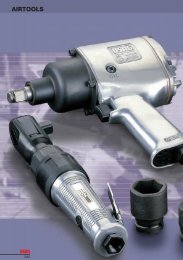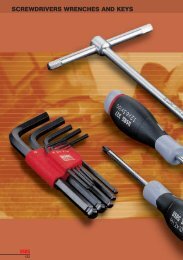Industrial seal self study guide - SKF.com
Industrial seal self study guide - SKF.com
Industrial seal self study guide - SKF.com
Create successful ePaper yourself
Turn your PDF publications into a flip-book with our unique Google optimized e-Paper software.
Chapter 6—Wear Sleeves<br />
How Shafts Wear<br />
Seals operate with a closely controlled interference at the interface.<br />
Continuous contact between a rotating shaft and a <strong>seal</strong> produces shaft<br />
polishing friction. Under normal conditions, the friction causes a slight<br />
wear track on the shaft (fig. 6a). However, as operating conditions<br />
begin to worsen, shaft wear can accelerate. Dust, heat, dirt, shaft<br />
speed, lack of lubrication, and even a cocked <strong>seal</strong> can cause the <strong>seal</strong><br />
lip to groove the shaft. Mechanical eccentricities can cause direct,<br />
metal-to-metal contact between the <strong>seal</strong> and shaft surface.<br />
The ultimate result is a leak.<br />
How to Identify Seal Worn Shaft Surfaces<br />
It’s not always easy to identify <strong>seal</strong>-worn shaft surfaces. The shaft may<br />
be visibly scored or grooved. You can catch your fingernail in a wear<br />
groove. A new <strong>seal</strong> that leaks soon after it’s installed is another telltale<br />
sign of shaft damage.<br />
The shaft surface can be<strong>com</strong>e so deeply grooved and worn that<br />
a new <strong>seal</strong> will not eliminate leaks, nor <strong>com</strong>pensate for the shaft<br />
damage (fig. 6b).<br />
Seal replacement does not solve the problem. The new lip will ride in<br />
the rough, worn <strong>seal</strong> track and the new <strong>seal</strong> will leak and wear out<br />
quickly.<br />
Three solutions are possible:<br />
• Reworking or metallizing the shaft surface at a machine shop—<br />
high cost, requires hours of downtime.<br />
• Replacing the shaft—Also expensive, with machine downtime.<br />
• Installing a wear sleeve—Comparatively low in cost, virtually no<br />
downtime, longer life.<br />
Wear sleeves correct shaft damage instantly with the least amount of<br />
downtime and cost. Wear sleeves require no special preparation or<br />
machining of the shaft for installation. Applied over the damaged shaft,<br />
a wear sleeve makes the shaft usable again. It eliminates shaft leaks<br />
and smooths out damaged surfaces. And often the new shaft finish<br />
created is better than the original.<br />
<strong>SKF</strong> offers two types of wear sleeves: Speedi-Sleeves ® , for nominal<br />
shafts .472” to 8.000” (12.00 to 203.20mm), and large diameter wear<br />
sleeves, for shafts 8” to 45” (203.20 to 114.300mm). Made of<br />
carbon steel and chrome-plated, the wear sleeve resists corrosion<br />
in a wide range of applications.<br />
Shaft<br />
O.D.<br />
W<br />
As a <strong>seal</strong> continuously contacts<br />
a rotating shaft, it creates shaft<br />
wear (fig. 6a).<br />
Shaft surface can be<strong>com</strong>e so<br />
deeply grooved and worn that a<br />
new <strong>seal</strong> will not eliminate leaks,<br />
nor <strong>com</strong>pensate for the shaft<br />
damage (fig. 6b).<br />
6<br />
53







